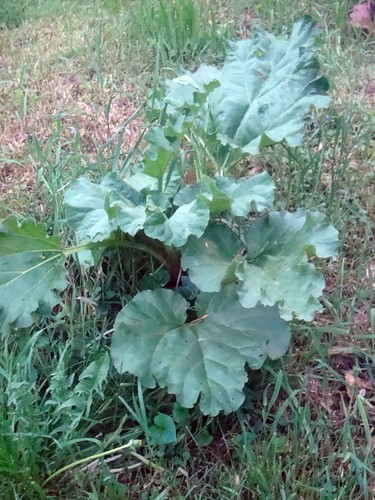I've always been fond of rhubarb, though I didn't get to have it very much when I was a kid. My mother didn't really like it, and we didn't have a garden (I never had a garden of "my own" until I got married - Maryanne and her family always gardened, so I kinda married into it.)
Anyway, one of the plants on the edge of the garden at our old house was a big rhubarb cluster - one with a geneology, no less. The original roots were one of the few things that Maryanne's grandmother brought with her when she immigrated to the US in the early 1900's. Planted and divided and recultured whenever she moved, they finally found a permanent home in the 1920's when she and Maryanne's grandfather built their permanent home. Some of the roots were moved to her son's house a few towns over in the 1950's, and were moved again to Maryanne's mother's house in the mid-1960's.
By the 1970's, what was left of the original roots were gone from the old homestead, having been distributed out to family members or allowed to die off. When Maryanne and I moved to the house we are in now - the house her grandfather built - we took a couple clumps of the heirloom rhubarb with us and it's back again at it's old home. The soil here hadn't been worked as constantly as at our old place and it's kind of poor; we keep working compost and natural fertilizer into it to bring it up to standard, but it's taking awhile. The rhubarb isn't as full and gorgeous as it was before we moved, but I'm pretty sure it will make a decent comback, given some time and TLC.
Rhubarb and New England are old friends. The first rhubarb plants in the US came in through Massachusetts and Maine in the 1820's, and spread out from there. It winters over well, and emerges in the spring fairly early - in fact, it's one of the very first things that can be picked out of the garden. I can imagine that in dirt-poor New England farming towns of the mid-1800's, having a fresh rhubarb pie on the table after a long winter of root vegetables and salt pork was a huge treat. It's so closely linked with early-season pies, in fact, that one of rhubarb's nicknames up here is "pieweed."
Over the years, rhubarb has moved out of pies and into salsas, chutneys, and sauces in ways that Maryanne's grandmother wouldn't have dreamed of. There are tons of recipes all over the web for that stuff. I'm just going to share a the boring old recipe for rhubarb pie that I've been using for years.
Rhubarb Pie
Makes 1 pie
3 cups rhubarb, in 1-inch slices
3/4 cup sugar (I like my pie a little tart, use more if you wish)1/2 tsp cinnamon
3 tablespoon flour
a dash of salt
2 tablespoons butterPastry for a 2-crust pie
Combine rhubarb, sugar, cinnamon, flour, and salt. Toss well to combine, and allow to stand while you prepare the pastry and line a pie plate.
Tip the rhubarb mixture into the pie plate and dot with bits of the butter. Cover with a pastry top - a lattuce crust is traditional for rhubarb pie, but I like to cover it with a sheet of pastry and then cut interesting decorative vents.
.


1 comment:
Mmm, nothing like a hearty slice of some rhubarb pie....
Post a Comment